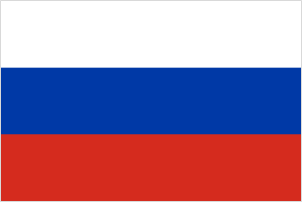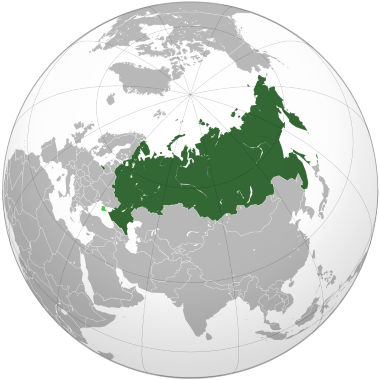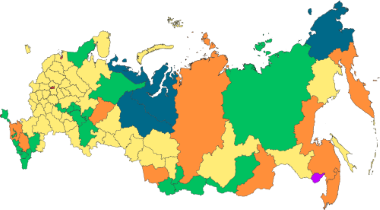Russia
Nga (tiếng Nga: Россия, chuyển tự. Rossiya, IPA [rɐˈsʲijə], quốc danh hiện tại là Liên bang Nga[6][7] (tiếng Nga: Российская Федерация (trợ giúp·chi tiết), chuyển tự. Rossiyskaya Federatsiya, IPA [rɐˈsʲijskəjə fʲɪdʲɪˈraʦəjə]), là một quốc gia ở phía bắc lục địa Á - Âu (châu Âu và châu Á)

National flag - Wikipedia

View on Google

View Map
The Ural Mountains form the boundary between you European and Asian Russia. European Russia lies to the west of the mountains. This vast stretch of land is home to more than 100 million people 2/3 of the entire Russian population. Most people live in the big cities of Moscow - the capital of the country - and St Petersburg, oa along the Volga river valley. The land is rich in minerals. It is also intensively farmed, with wheat and other grains in the long north giving way to tobacco, citrus fruit, and a variety of crops in the warmer south.
St Petersburg
with it's network of canals and rivers, the elegant city of Saint Petersburg is known as Venice of the North. It is a centre for arts and culture and how many fine century buildings. It was the capital of Russia between 1713 an 1917. Under communist rule city were renamed Leningrad to honour Lenin, the leader of the 1917 Russian Revolution. With the collapse of Communism in 1991, it reverted to its old name.
Agriculture
Because of the harsh climate, only ten percent of Russian land used for growing crops, mostly in an area known as the fertile triangle. The country is the world's leading producer of oats and rye, and the world's second biggest producer barely and potatoes. During the 1950s a vast area of barren land in South Central Russia was cultivated, the largest expansion of agriculture in the last 100 years. The new Wheat fields freed up more fertile areas in the west to grow fodder for animals.
Russian Ballet
Ballet arrived in Russia from France in the 19th century, thanks to closed cultural and diplomatic ties between Paris and St Petersburg, the old Russian capital. By the early 20th Century , Russian had transformed traditional ballet, making it more creative and exciting. Today, the Bolshoi ballet of Moscow and the Kirow ballet of Saint Petersburg are known throughout the the world.
Food and drink
The basic Russian diet, consisting of grain, potatoes, oil and sugar, tends to be fattening. Forest fruit, vegetables, and meat are regarded, however, increased food production and a better system of supply has led to a wider range of foods on sale in the big cities.
The Tatars
the ancient of Kazan, on the Volga, is the capital of Tatarstan, home to around 2 million Tatars. These Islamic peoples are descendants of the Mongols, who overran Russia in the 13th century.
Industry
the former Soviet Union invested heavily in its industry. vast industrial complexes were build in the Iron-rich Ural mountains and in the Kuzbass coalfield of southern Siberia. The production of coal, iron, and other minerals soared, and heavy Industrial such as engineering steel, iron, and Chemical production, dominated the economy. However Russia is now paying a price for this big advence. Many factories are old and inefficient, polluting the environment with harmful emissions.
Market economy
When the USSR collapsed in 1991, the state-run, planned economic went with it. Switching abruptly to a liberal western style economy caused many problems for ordinary Russians,widening the gap between rich and poor. A server crisis in 1998 has been largely overcome, but Russia is still struggling to achive western-style prosperity.
Women workers
Many more Russian men than women died during the World War II and in the labour camps set up by the Soviet leader Stalin. As a result there are far more women than men in Russia. And women make up around 50% of the Workforce. Good child care and medical services enable women with children to go out to work. Many work on the railways or drive buses and trams. Most factories have largest female Workforce and many professions at medicine, dentistry, and teaching, are dominated by women.
The Moscow Metro
During the 1930s the soviet goverment build a huge underground Railway system beneath the streets of Moscow. The system a fast and efficient and used daily by more than 7 million people. The stations were built deep down in the ground so that they could be used at airraid shelters during wartime. Many are beautiful decorated with paintings, sculpture, and mosaics.
Kamchatka
Hanging of the eastern end of Siberia, the Kamchatka Peninsula is one of the most isolated parts of Russia. Under the Soviet Union, Kamchatka bristled with Military Base because of it's closeness to both Japan and the USA. Today the military presence is reduced and people are returning to more traditional ways of making a living. Once more, people are fishing in the many rivers, herding reindeer, or hunting seals, sea otters and bears for their skins.
The Trans- Siberian Railway
The Trans-Siberian Railway is the world's longest continuous rail line. It begins at moscow's yaroslavl station in the West and streetches 9440 kilometer appropriate 5866 miles a cross to Vladivostok in the east. Trains cross eight-time zones and take eight days to complete the journey. In recent years the line has become increasingly congested. New lines including that Baikal Amur Mainline, have been built alongside to relieve this problem.
Arts and crafts
The rise in Russian nice and nationalism has been accompanied by a return to tradition crafts, folk tales, and music and dance. Skilled craftworkers make boxes and other items from food or paper mache. The lacquered boxes are decorated with miniature paintings.
Closed and secret cities
Closed cities including Vladivostok were sites off military or Industrial importance.
Raw materials
Siberia is rich in natural resources with huge reserves of oil, gas, coal, Metals, diamonds and gold. The trans Siberian Railway transport vast amount of minerals from Siberia to European Russia. Western Siberia contains one_third of the world's natural gas reserves, as well as a huge oilfield producing 8.4 million barrs of oil a day.
Chess: The ancient game of chess became popular in Russia as a way of spending long, dark winter evenings by the fireside. Today, chess is still widely played here. Russian Grand Master such as Karpov and Spassky have dominated world chess tournaments. During a big match, gaint chessboards are displayed in big city squares for the public to follow the competitior's moves.
Forestry: The taiga forest of northern Russia anf Siberia provides work in logging, paper production, chemicals, and furniture making. In the past, most forestry jobs were in the more accessible parts of northern Russia. But many of these forests have been cleared, and new seedlings take up to 80 years to produce mature wood. As a result, the centre of the forestry industry has moved south and east into Siberia near Lake Baikal or the Amur river near the Pacific coast.
Living in a cold climate: The Yakut people of eastern Siberia are used to living in a cold climate, as winter temperatures drop to -43oC. Engines are kept running 24 hours a day to prevent them freezing up. Drinking water is delivered as chunks of ice sawn out of the local river. Even during the brief summer, most ground remains frozen hard. Houses are often built on raised concrete platforms or wooden stills to protect them from frost damage.
Fur farms: For centuries, hunters and trappers have worked the Siberian forests to catch ermine, mink, sable, lynx, and fox. In order to protect some species from over-hunting, the Soviet goverment introduced fur farms, where breeders raise rare animals for their furs. Furs from Siberian animals are turned into hats, coats, and linings for boot and gloves.
Lake Baikal: Known as the "blue eye od Siberia", Lake Baikal in southeastern Siberia covers 31.468 sq km and is u to 1.940 m deep. It is the deepest lake in the world and the largest freshWater lake, containing more than 20 percent of the world's entire supply of fresh water. In recent years, logging and chemical industries have polluted the water, prompting a major campaign to protect this unique environment.